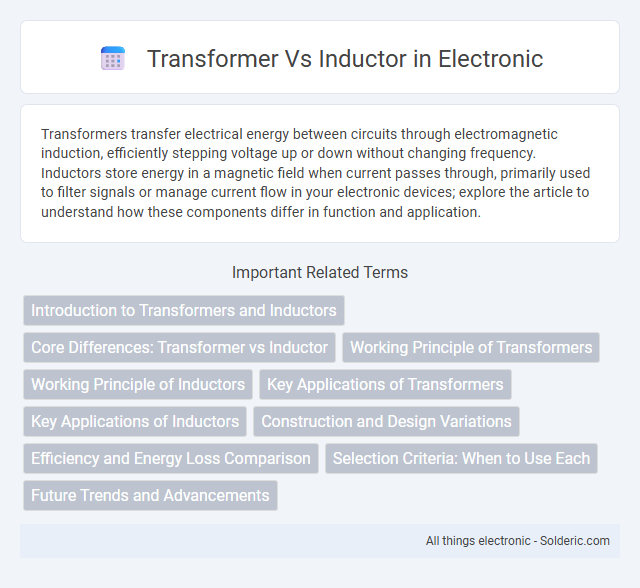Transformers transfer electrical energy between circuits through electromagnetic induction, efficiently stepping voltage up or down without changing frequency. Inductors store energy in a magnetic field when current passes through, primarily used to filter signals or manage current flow in your electronic devices; explore the article to understand how these components differ in function and application.
Comparison Table
| Feature | Transformer | Inductor |
|---|---|---|
| Primary Function | Transfers electrical energy between circuits via electromagnetic induction | Stores energy in a magnetic field when current flows through it |
| Structure | Two or more coils (windings) wrapped on a magnetic core | Single coil or winding often on a magnetic core or air core |
| Use Case | Voltage step-up/step-down, impedance matching, isolation | Filtering, energy storage, limiting current changes |
| Operation Frequency | Wide frequency range, from Hz to MHz depending on design | Typically low to high frequencies; depends on core and winding |
| Energy Transfer | Transfers energy between circuits | Stores energy temporarily within one circuit |
| Voltage Transformation | Yes, changes voltage levels | No, voltage across inductor depends on current change rate |
| Magnetic Core | Usually iron or ferrite core to increase coupling | Iron, ferrite, or air core depending on application |
| Symbol | Two coils side by side or linked by a line | Single coiled inductor symbol |
| Energy Storage | Minimal, mainly transfers energy | Primary function is energy storage in magnetic field |
Introduction to Transformers and Inductors
Transformers and inductors are fundamental electromagnetic components used in electrical circuits to manipulate voltage and current. Transformers transfer electrical energy between circuits through electromagnetic induction, typically to step voltage levels up or down, while inductors store energy in a magnetic field when current flows through them, primarily influencing current and filtering signals. Understanding the distinct roles and construction of transformers and inductors helps you optimize circuit design for power management and signal processing applications.
Core Differences: Transformer vs Inductor
Transformers consist of two or more windings on a shared core designed to transfer electrical energy between circuits through electromagnetic induction, enabling voltage stepping up or down. Inductors have a single winding around a core that stores energy in a magnetic field when current flows, primarily used for filtering, energy storage, or impedance matching. Your choice between a transformer and an inductor depends on whether you need voltage transformation or energy storage and regulation within an electrical system.
Working Principle of Transformers
Transformers operate on the principle of electromagnetic induction, where an alternating current in the primary coil creates a varying magnetic field that induces a voltage in the secondary coil. This process allows for the transfer of electrical energy between circuits at different voltage levels without direct electrical connection. Unlike inductors, which store energy temporarily in their magnetic field, transformers transfer energy efficiently through mutual inductance between coils.
Working Principle of Inductors
Inductors operate on the principle of electromagnetic induction, storing energy in a magnetic field when electric current passes through their coil. This property causes inductors to resist changes in current, making them essential for filtering, energy storage, and tuning circuits. Your circuits benefit from inductors by stabilizing current flow and smoothing out voltage fluctuations.
Key Applications of Transformers
Transformers are essential in electrical power distribution, enabling voltage step-up and step-down for efficient transmission and safe consumer use. They are widely used in electronic devices to isolate circuits and match impedance for optimal performance. Unlike inductors, transformers facilitate energy transfer between circuits through electromagnetic induction, making them critical in power supplies and signal processing.
Key Applications of Inductors
Inductors are primarily used in power supply filters, energy storage in DC-DC converters, and RF chokes to block high-frequency signals while allowing low-frequency currents to pass. They play a crucial role in tuning circuits, signal processing, and electromagnetic interference (EMI) suppression. Unlike transformers, which transfer energy between circuits through magnetic coupling, inductors store energy in a magnetic field to regulate current flow in electronic devices.
Construction and Design Variations
Transformers consist of two or more wire-wound coils called windings, usually wrapped around a laminated iron core to efficiently transfer energy through electromagnetic induction, while inductors typically have a single coil wound around a core that can be air, iron, or ferrite. Transformer design variations include power, isolation, and autotransformers, which differ in winding configurations and core materials to optimize voltage conversion and electrical isolation. Inductor designs vary by shape, core type, and application, such as toroidal, solenoid, and choke inductors, each tailored to your circuit's inductance and frequency requirements.
Efficiency and Energy Loss Comparison
Transformers typically exhibit higher efficiency than inductors due to their design, which minimizes energy loss through better magnetic coupling and lower resistive heating. Inductors experience greater energy loss primarily as heat from coil resistance and core hysteresis, especially in high-frequency applications. Understanding these differences helps you optimize energy usage in electrical circuits by selecting the appropriate component for minimal power loss.
Selection Criteria: When to Use Each
Transformers are ideal for voltage conversion and isolation in AC circuits, especially when precise voltage regulation and impedance matching are required. Inductors are preferred for energy storage, filtering, and noise suppression in both AC and DC circuits due to their ability to resist changes in current. Selection depends on application needs: use transformers for power distribution and signal isolation, while inductors suit tasks like smoothing power supplies and tuning circuits.
Future Trends and Advancements
Future trends in transformers and inductors emphasize higher efficiency, miniaturization, and integration with smart grid technologies, driven by advancements in materials like nanocrystalline cores and developments in power electronics. Emerging designs prioritize reduced energy loss, enhanced thermal management, and improved electromagnetic compatibility to meet the demands of renewable energy systems and electric vehicles. Your choice between transformers and inductors will increasingly depend on these innovations that enable more compact, efficient, and intelligent power conversion solutions.
transformer vs inductor Infographic

 solderic.com
solderic.com